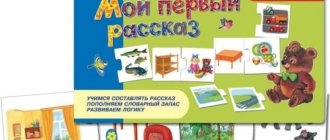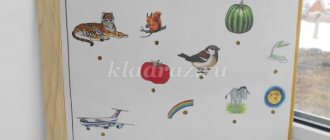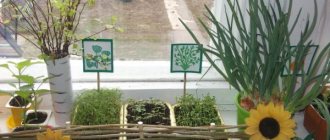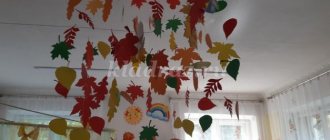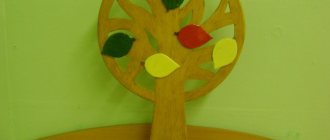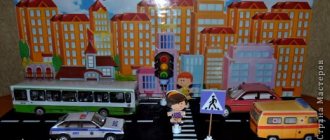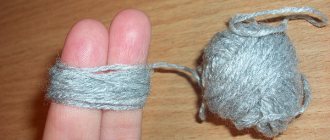Didactic manual “Miracle Tree” for kindergarten
Didactic manual “Miracle Tree” for preschool children
Didactic manual “Miracle Tree”
Description. I bring to your attention the teaching aid “The Miracle Tree”. The material is intended for kindergarten teachers. The manual can be used on lexical topics “Birds”, “Fruits”. And also for automation and differentiation of sounds. Multifunctionality lies in the use of different pictures. The manual is designed for individual and subgroup work with preschool children. Method of making the manual. Take a sheet of A4 paper, draw a picture of a tree on it or use a ready-made image. Laminate it with film for pasting textbooks.
Cut nest-pockets from transparent film and attach to tree branches using double-sided tape.
Select pictures of birds and cover them with tape.
Didactic game “Birds in nests”
Purpose: To consolidate children’s knowledge and ideas about migratory and wintering birds. Clarify the name of the birds, practice recognizing birds by their description. Learn to coordinate nouns with numerals. Develop phonemic awareness, determine the presence of sound in a word. Automate the sounds L, R, Rub, S. Game options.
1 task “Say it in one word”
Pictures of birds are laid out in front of the child. The teacher asks the child to name who is shown in the pictures. Then he suggests choosing a generalizing word.
Task 2 “Wintering birds”
The teacher invites the child to select and place only wintering birds in the nests. The child resettles the birds by pronouncing their names.
Task 3 “Count and name”
The teacher places the birds on the tree and asks the child: “How many birds have arrived?” The child counts the birds and sums them up at the end of the count. For example, one rook, two rooks...five rooks. Five rooks flew in.
Task 4 “Where is the bird sitting?”
The teacher invites the child to place the birds on a tree branch, above a tree, under a tree, on a branch. The child seats the birds, pronouncing their location.
— A crow over a tree. - Magpie on a tree. - Rook under the tree. — The sparrow is to the right of the tree. — The rook is to the left of the tree. The teacher monitors the correct use of prepositional-case constructions.
Task 5 “Find out by description”
The teacher asks the child to guess riddles about birds. Nimble, fast, dexterous, pugnacious, brave, fighting ... (sparrow) Red-headed, large, smart, wintering ... (woodpecker) Nimble, cheerful, long-tailed, migratory ... (swallow) Big-eyed, sleepy, nocturnal, sedentary, wintering ... (owl) The child guesses the bird, names it and places it in the nest.
Task 6 “Birds in nests”
The teacher asks the child to place in the nests only those birds whose names contain the sounds S, S'. Similarly with the sounds R, Rb, L.
Task 7 “Who flew away?”
The teacher places birds on the tree whose names contain the sound S. Invites the child to look carefully and remember the birds. Then the child closes his eyes, and the teacher removes one bird. Who flew away?
Task 8 “Who’s the odd one out”
The teacher places birds in nests: jackdaw, swallow, dove, oriole, woodpecker, falcon and crow. Invites the child to look carefully and find the extra bird whose name does not have the sound L.
We recommend watching:
Do-it-yourself multifunctional game aid for preschoolers Do-it-yourself didactic aid for younger preschoolers Do-it-yourself didactic aid for kindergarten Do-it-yourself didactic aid “Paired Pictures” for kindergarten
Similar articles:
Game layout for children 4-7 years old “My City”
Multifunctional teaching aid for children 5-6-7 years old
Do-it-yourself manual for developing fine motor skills
“Didactic multifunctional manual “Seasons””
“Didactic multifunctional manual “Seasons””
Author: Trostyanskaya Asya Yuryevna, teacher of the municipal government preschool educational institution of the city of Novosibirsk, kindergarten No. 5 “Zvezdochka” of a combined type.
The didactic multifunctional manual “Seasons” is intended to develop children's ideas about seasonal changes in nature. The manual in a playful way will teach the child to classify, compare, find similar
qualities and differences. The child can easily talk about the characteristic features of each season. Thanks to elements with Velcro fastenings, he will be able to independently decorate the tree according to the seasons. This manual will help organize joint and independent activities during the study, consolidation of specific topics (seasons, wildlife, wintering birds, etc.). The manual “Seasons” is designed for preschool children from 3 to 7 years old.
The manual includes: - a dynamic model in the form of a three-dimensional tree, made of plywood, which is safe and environmentally friendly for children
— elements with Velcro fastenings (foliage of different colors, snowflakes, flowers, birds, fruits, flowers); available to children from 3 years of age for independent use (develops fine motor skills);
-figures of birds, insects, fruits, leaves, etc. (made of felt)
- methodological developments using the manual contain practical material for conducting classes with one child or a subgroup of children in order to study new and consolidate previously studied material - (card file of games, walks, oral folk art, wintering and migratory birds with descriptions, insects, flowers, fruits and etc).
This manual is a combination of a didactic task, the implementation of speech capabilities, visualization of specific images, and the permissibility of manipulation with these images.
Goals:
1. Improve children’s basic understanding of the seasons based on a model that contains distinctive features (leaves, snowflakes, birds, plants, animals, etc.).
2. Compose a story - a description, based on the model of a certain time of year.
3. Continue to develop the ability to depict the seasons using object modeling.
4. Foster a desire in children to work with models.
5. To introduce preschool children to the beauty of nature through the organization of joint artistic and creative activities of children, parents and teachers.
6. To develop the ability to play, performing various roles, to see the events and interests of others, to comply with norms and rules.
Tasks:
Educational:
- expand and enrich children’s ideas about the changes that occur in nature in different seasons;
— enrich vocabulary;
- intensify speech;
Developmental;
— develop the ability to correlate natural phenomena with seasonal changes;
— to form interest in cognitive activity;
Educational;
- cultivate friendly relationships with peers;
- cultivate love and respect for the environment;
The manual can be used in joint (partnership) activities of a teacher with children, educational activities in restricted moments (walks, individual work in the morning and evening hours, etc.). In organizational educational activities, gaming, problem-based learning situations, etc., children’s independent activities, and the type of activity (game, cognitive-research, motor, productive), their interest in this activity, the complexity of the material.
Expected result:
— allows you to reveal the important features of natural objects and the natural connections that exist in it;
— develops the child’s ability to consistently build conclusions, give reasons for his opinions, and compose a descriptive story;
— develops children’s cognitive abilities, interest, curiosity, imagination and creative activity;
— enriches and refines children’s knowledge about the life of animals and birds in the forest, teaches them to name the distinctive features of their appearance;
— forms mathematical representations;
— fosters emotional responsiveness;
- consolidates and systematizes the studied material, and reviewing it in the future allows you to quickly refresh your memory of the topics covered;
- helps the child, at will, organize information on the topic being studied and better understand and remember the material (considering that preschoolers have visual-figurative thinking);
- a preschool child learns to independently collect and organize information - good preparation for school;
- promotes quick memorization of poems, finger gymnastics;
- promotes increased interest in the content, independence when working with the manual, and interest on the part of parents;
- teaches a comprehensive analysis of a problem, setting tasks and solving them, creatively approaching the issue of organization and selection of information;
- develops skills of voluntary switching of attention, increases the level of visual-effective thinking and visual perception, develops visual-motor reaction in children’s activities.
The manual is mobile, accessible to children, multifunctional, suitable for both group and individual use, including with the participation of an adult;
It has didactic properties, is a means of artistic and aesthetic development of the child, introduces him to the world of art;
— variability (there are several options for using each part);
— provides playful, educational, research and creative activity for all pupils.
By using the didactic multifunctional manual “Seasons” in your work, it will be possible to prepare just such a person for a new life in new conditions. “Seasons” is a method that helps consolidate and practice acquired knowledge, which can give the desired results; this is a study that will last a lifetime.
This multifunctional didactic guide helps organize games with children: “What time of year”, When does it happen”, “Who eats what”, “Who winters where”, “What fruits do you know?”, “Count” and much more. Used on mathematics classes with additional handouts, on familiarization with the surrounding world “Wintering and migratory birds” (habitat at different times of the year), on speech development we compose descriptive stories, etc.
Exercises (games) on the theme “Seasons”
Purpose of exercises (games): development of fine motor skills; tactile sensations.
1. Exercise “Attach flowers (apples, leaves, snowflakes)”
It can be played by one or two people. It can be in the form of a timed competition.
The development of coherent speech according to this manual occurs in an inextricable connection between word and action, since during his story the child attaches the missing details to the worksheet. Children learn to formulate their statements grammatically correctly, understand and use prepositions.
1. Exercise “Place it in order”
Task: arrange the worksheets in the correct sequence one after another and tell what changes occur when the seasons change.
2. Exercise “Tell me about the time of year.” Task: talk about the signs of the selected season using the appropriate mnemonic table.
3. Exercise “Answer the question”
Questions “Where do apples grow?”, “Where do flowers grow,” etc.
Task: Answer the question using prepositions correctly.
4. Exercise “Put into baskets.” Task: classify vegetables and fruits
5. Exercise “One - many.”
Task: form the plural of a noun.
Didactic games “Seasons”
1. Game “Choose and Explain!”
Progress of the game:
On the playing field, children choose one of four seasons. The presenter shows a card corresponding to a certain time of year. Children choose and name an image if it corresponds to the time of year chosen by the child. The winner is the one who accurately and ahead of everyone uses these cards offered by the presenter.
2. Game “What’s wrong?”
Progress of the game:
You can place several mismatched pictures in different sectors and invite children to put them where they should be. Or arrange competitions: some arrange, and others decide whether it is correct or not.
To assimilate the material and make the educational game “Seasons” more interesting, it is possible for a teacher to be present in the game to enhance speech activity and use riddles.
The didactic manual helps to organize games with children: “What time of year”, When does this happen”, “What fruits do you know?”, “Count” and much more.
Game “Find out by description” Goal: to develop logical memory and imagination. Game “What is missing” Goal: to develop memory, attention, observation; exercise in the formation of the genitive case singular. Game “Walk in the Forest” Goal: to develop observation skills, introduce seasonal phenomena in winter. Game “What’s above, what’s below” Goal: to develop the ability to determine the position of objects relative to each other.
Game “When It Happens” Purpose: to consolidate children’s knowledge about the seasons. The games proposed on the topic “Winter” can also be used when considering other seasons of the year. When considering the topic “Spring”, you can play educational games “Who was awakened by the sun”, “ Who came to visit.” When considering the topic “Summer”, add the games: “One - many”, “Big - small”. When considering the topic “Autumn” - games “Stocks for the winter”, “Gifts of Autumn”. Thus, using layout “Tree. Seasons", I solve several didactic tasks: - develop visual - figurative and verbal - logical thinking; - form the ability to highlight significant connections between objects and natural phenomena; - expand the understanding of animals and insects, cultivate a caring attitude towards nature.
Game Miracle Tree
Game "Miracle Tree"
game for grades 3-7
The proposed game will allow children to be introduced to the wonderful world of plants in an interesting, entertaining way and, perhaps, will encourage them to think about the fact that today trees need our protection more than ever.
Rules of the game.
The game involves four teams of up to 7 people. Each team chooses a captain and a name. Teams can be called like this: “Maple”, “Oak”, “Birch”, “Willow”. If the name is determined in advance, then the corresponding sign is attached to each gaming table before the start of the game. Before the game, it is necessary to select a jury that will determine the answering player and evaluate the correctness of the answer. The game action includes 4 rounds. Participants answer questions from the presenter. The question sounds to all teams at the same time. If the answer is ready, the captain must raise a leaf of his tree - this will be a signal to the presenter and the jury that the team is ready to answer. For each correct answer, the team receives one leaf (according to its name, i.e. a leaf of maple, oak, birch, willow). The team with the most leaf points wins.
Decor. A hall or classroom can be decorated with tree branches cut out of paper, flowers, and leaves. You will need four gaming tables. On the wall or on the chalkboard there is a playing field - a drawing of a tree, on the branches of which the names of the game’s rounds are written.
This is a tree without leaves. Each team that correctly answers the leader’s question attaches (with tape, needles or glue) its leaf to this tree. In this way, participants and spectators will have the opportunity to follow the progress of the game, and at the end of the intellectual competition, the scoreboard tree will be covered with leaves.
Leading. In many fairy tales, people go to distant lands to the thirtieth kingdom to look for a wonderful miracle, more marvelous. But there are a great many miracles around! Here is one of them: next to the house or by the road, in a grove or in a forest. This is a tree! So familiar at first glance, it is fraught with so many unusual things...
Questions:
ROUND 1
And in Rus'.
1. In some Russian provinces there was a custom of placing a birch log at the threshold. For what? (It was believed that the birch tree protects from evil, being a barrier to evil spirits.) 2. This tree has long been considered the best honey plant in Rus'. Its dried flowers make an excellent cold medicine. What kind of tree is this? (Linden tree.) 3. Guess the riddle: It makes you happy in the spring, It cools you in the summer, It nourishes you in the fall, It warms you up in winter. (Tree.) 4. Why were the domes of churches in Rus' sometimes made of aspen? (It was believed that aspen, like birch, is a tree that exorcises evil spirits). 5. In the old days, Russian people spoke of the birch as a tree “about four things.” What are these things? Name it. (1. They made splinters from birch that were not smoked. 2. They lubricated the wheels with tar made from birch bark. H. They healed wounds with a decoction of birch buds. 4. they made birch brooms for the bathhouse.) 6. The timber lies across all of Rus', on This beam has 12 nests, each nest contains 4 eggs, and each egg contains 7 chickens. What kind of timber is this? Think about what this riddle is a figurative formulation of? (Time.) 7. Why were rods made from birch in Rus'? (To cast out demons from a careless student.) ROUND 2
. In the depths of centuries.
Questions: 1. What is the name of the science that studies fossil animals and plants? (Palaeontology.) 2. What is the name of the tree, according to legend, punished by Christ? (Fig tree. According to legend, Christ punished the fig tree for infertility. Not finding any fruit on the fig tree, he cursed the tree, after which it withered to the roots.) H. How was amber formed? (Amber is the fossilized resin of pine trees that grew on the seashore about 40 million years ago.) 4. The ancient Romans called it “quercus,” which means “handsome.” This tree in ancient Rome became the tree of the supreme god Jupiter and was considered sacred. What kind of tree is this? (Oak) 5. What plants grew in primeval forests about 420 million years ago? (Ferns, mosses, they were replaced by ferns and horsetails.) b. In which country was Europe's first large botanical garden founded in 1594? (In Holland.) 7. During the construction of the first Russian fleet, by decree of Peter 1, forest lands near Voronezh were declared a ship grove. This grove provided the best material for building ships. What trees grew there? (Oak trees.)
ROUND 3
Trees and myths
Questions: 1. Apollo's friend accidentally killed his favorite deer and, in order to be sad forever, asked to turn it into a tree. God fulfilled his request. What is the name of the hero after whom the tree of sorrows is named? (Cypress.) 2. What is the name of the tree located in the center of the world in mythology and poetry? (The world tree. Through it, knowledge of life and death, good and evil occurs) Z. Laurels are still crowned today by winners - poets, musicians, chess players. In ancient Greece, the heads of the winners of the Olympic Games and great poets were decorated with a laurel wreath. Where did the laurel wreath come from? Tell us this sad story, remembering the myth. (The solar god Apollo was struck by the arrow of love, and the daughter of the river god Peneus Daphne - by the arrow of hatred and disgust. Having fallen in love, Apollo pursued her everywhere, but Daphne did not reciprocate. Heeding his daughter’s request, Peneus turned her into a laurel tree. “Let the wreath only of your greenery adorns my head," exclaimed Apollo. This custom of crowning great people with laurels has survived to this day.) 4. The ancient Greeks believed that this tree was given to them by Athena, the goddess of wisdom and the patroness of peaceful labor. She argued with the god of the seas, Poseidon, over the possession of this blessed land. Athena stuck her spear into the rock, and it turned into a tree, which became a symbol of labor, peace and fertility. What is the name of this tree? (Olive tree.) 5. For the fruits of which tree did Hercules enter the Garden of the Hesperides? (Apple trees. The apples of the Hesperides were golden, and Hercules was sent for them by King Eurystheus.) 6. Who was the deity of the forests in Greek mythology? (The deity of forests, fields and the entire plant world in Greek mythology is Pai.) 7. The cheerful god of pastures Pai was horned, bearded, with goat legs. He liked the nymph Pythia, but she chose to turn into a tree just to get rid of Pan. What kind of tree is this? (Pine. Pan’s head has since been decorated with a wreath of pine branches.)
ROUND 4
All about trees.
Questions: 1. In winter, this tree looks like a dried spruce; in spring, the branches of the tree are covered with soft green needles; They turn golden in autumn and fall off in winter. What kind of tree is this? (Larch.) 2. Which tree is the last to bloom in central Russia? (Linden). H. In Canada, the sap of these trees is used to obtain sugar. In Russia, kvass was even prepared from the sap of this tree. Name it. (Norway maple.) 4. “Looking at them, you begin to understand the meaning of the old words: tents over your head. Obviously, such tents in former times were called canopies.” These are the words of K. Pausovsky. What tree did he say this about? (About willow.) 5. The wood of which tree has a number of amazing properties: in dishes made from it, milk remains fresh for a long time; Moths never appear in a closet made from its boards. (Cedar) b. What is the name of a shrub that can survive in the barren sandy deserts of Asia and North Africa? (Saxaul.) 7. If you meet these familiar trees in the south of Russia or Central Asia, you won’t recognize them. They are called pyramidal here. What kind of trees are these? (Poplars.)
At the end of the game, the jury sums up the results. The team with the most points is awarded a laurel wreath. The remaining participants in the game receive commemorative diplomas with a symbolic image of each team’s sheet.
………………….
